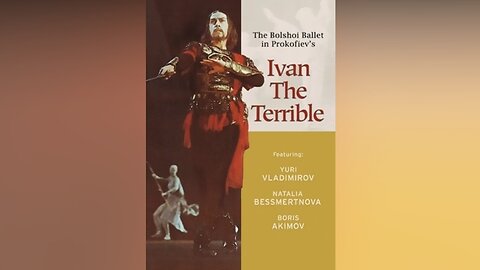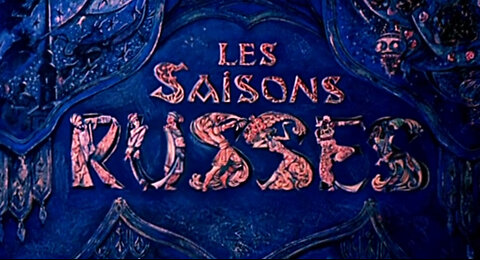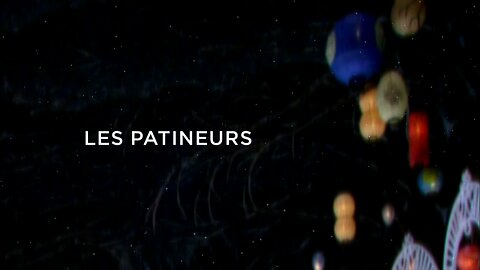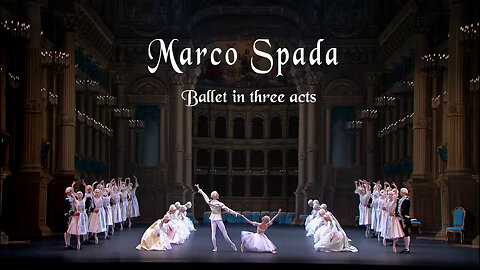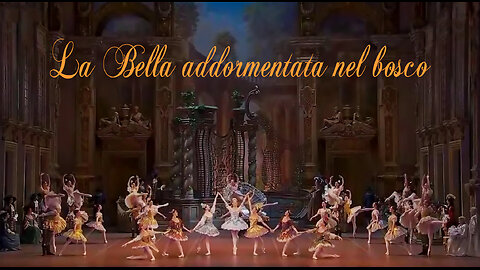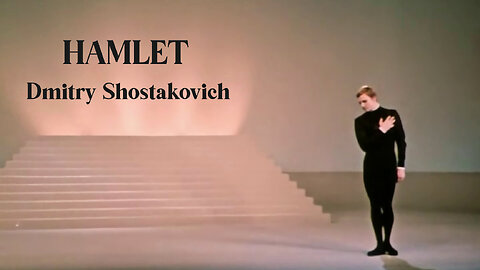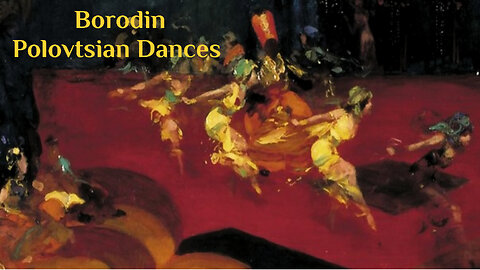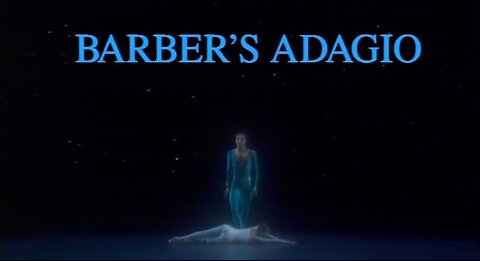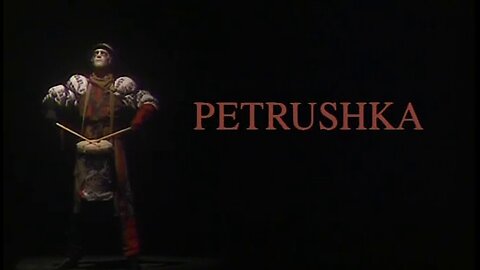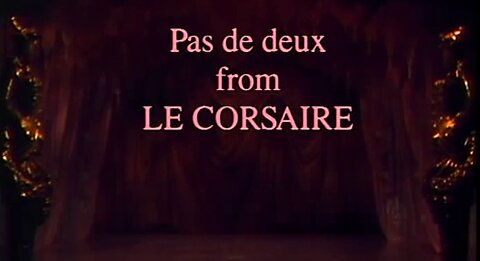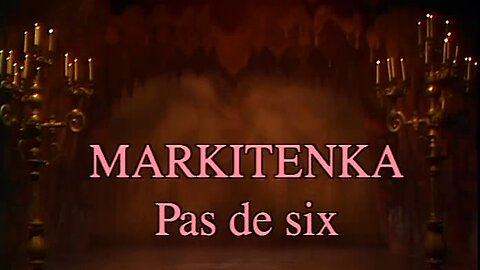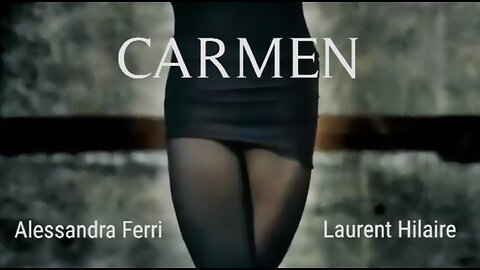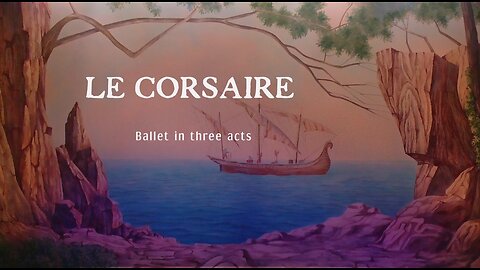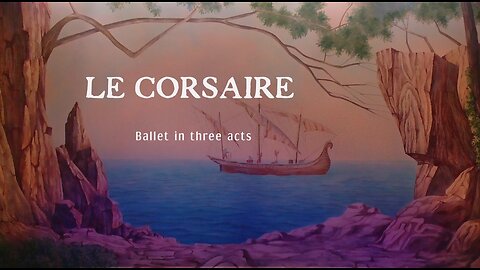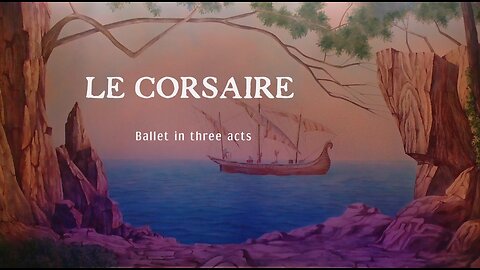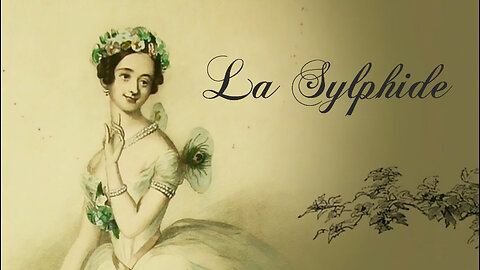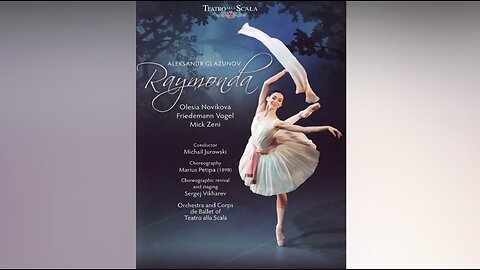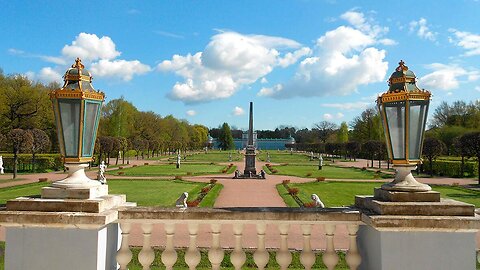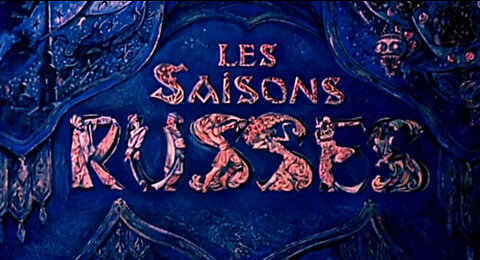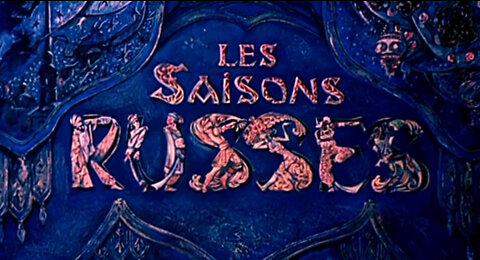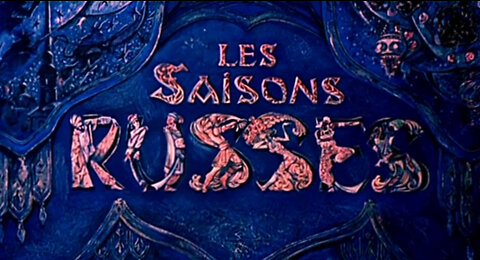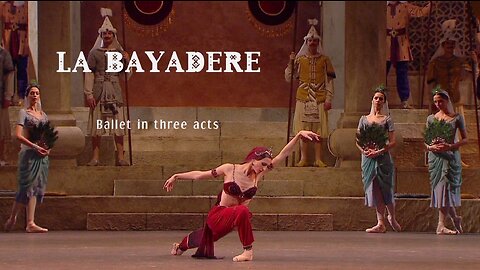Premium Only Content
This video is only available to Rumble Premium subscribers. Subscribe to
enjoy exclusive content and ad-free viewing.
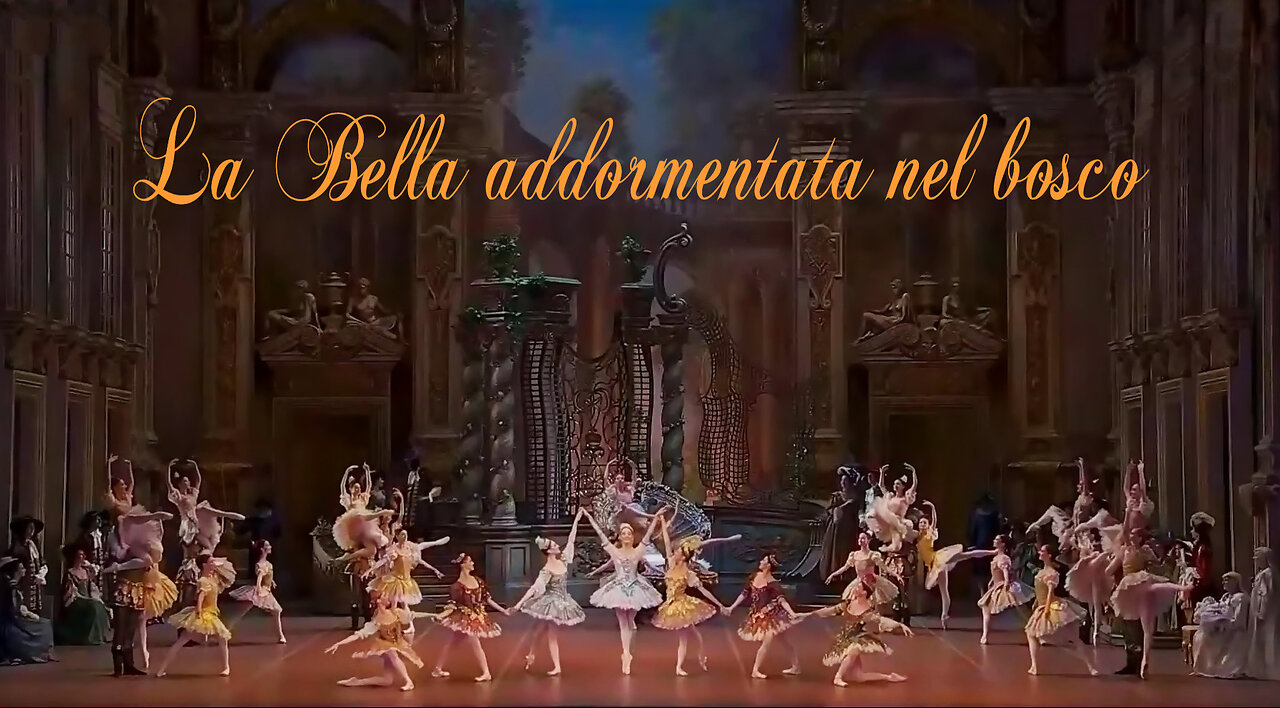
Ballet & Dance
AdanethArts
- 14 / 41
1
Christmas Carol - A Ballet (Finnish National Ballet 2023)
Adaneth - Arts & Literature
A Christmas classic revisited in dance form at the Finnish National Opera: Charles Dickens' A Christmas Carol. Recorded on 9 December 2023 at the Finnish National Opera and Ballet.
It's the story of Ebenezer Scrooge, a grumpy, miserly old man who, on Christmas Eve, is visited by the ghosts of Christmas past, present and future. A magical tale popular with all ages, adapted into a ballet by an all-British artistic team including composer Sally Beamish and choreographer David Bintley.
Director: Jussi Buckbee
Choreography: David Bintley
Director: Anna Fleischle
Composer: Sally Beamish
Costumes: Anna Fleischle
Music director: Paul Murphy
Finnish National Ballet
Finnish National Opera Orchestra
3
comments
2
Ivan the Terrible - Prokofiev | Vladimirov, Bessmertnova, Akimov (The Bolshoi Ballet 1976)
Adaneth - Arts & Literature
"Ivan the Terrible" is a classical ballet in 2 Acts. The world premiere of the ballet Ivan the Terrible took place at the Bolshoi Theater on 20th of February 1975. Yuri Vladimirov performed as the tsar, Natalia Bessmertnova as Anastasia, and Boris Akimov as Kurbsky. The second production, in 1977, was performed by Vladimir Vasiliev (Ivan IV), Lyudmila Semenyaka (Anastasia) and Boris Akimov ((Prince Kurbsky).
The premiere caused great resonance. That same summer the troupe toured in the USA, where „Ivan the Terrible” created a great sensation and collected innumerable comments from viewers and media. Next year the ballet was staged at the Paris Opera, where it met the same warm reception, and soon it was shown on the stage constructed specifically for this performance in Louvre during the summer season.
"Ivan the Terrible" is music by Sergei Prokofiev originally composed for the Sergei Eisenstein film about the sixteenth-century ruler. Prokofiev composed music to Part 1 in 1942-44, and to Part 2 in 1945; the score is cataloged as Op. 116. After the composer’s death, music for the film was arranged first into an oratorio (with speaker, soloists, chorus, and orchestra) by Alexander Stasevich (1961), who was the conductor of the film score, and later into a concert scenario by Christopher Palmer (1990).
It was Abraham Stassevitch, conductor for Sergei Prokofiev's score for director Sergei Eisenstein's "Ivan the Terrible - Part II" (1958), who proposed to Grigorovich that he transfigure IVAN, along with its music, into a full-length dramaturgic dance work. In 1973 the choreographer and theatre director of Bolshoi Yuri Grigorovich, commissioned the distinguished Soviet composer as well as professor of composition, Mikhail Chulaki, to create a balletic scoring based upon Eisenstein's cinema masterpiece. It is cobbled from 377 fragments from Prokofiev's Ivan Part II musical design in addition to other pieces by the great composer.
In 1976, based on this Bolshoi Theater performance, the film-ballet was shot, which was released on screens in 1978 by Mosfilm.
Composer: Sergei Prokofiev, in a musical edition and composition by Mikhail Chulaki
Choreography: Yuri Grigorovich
Costume Designer: Simon Virsaladze
Set Designer: Simon Virsaladze
Screenplay and Directors: Vadim Derbenev, Yuri Grigorovich
Artistic Director: Yuri Grigorovich
Cast & Characters:
Ivan the Terrible - Yuri Vladimirov
Anastasia - Natalia Bessmertnova
Prince Kurbsky - Boris Akimov
Ballet dancers and the orchestra of the Bolshoi Theater of the USSR
Conducted by Algis Žiūraitis
For Yuri Vladimirov, the title role became a milestone, and the part of Tsaritsa Anastasia became one of the most consistent to Natalia Bessmertnova’s acting personality and professional talents in her creative biography. The following tsars, which have always included artists, distinguished by technical virtuosity and endowed with acting temperament, – Mikhail Lavrovsky, Alexander Godunov, Irek Mukhamedov, Alexei Fadeyechev, Alexander Vetrov – left a vivid mark on this ballet’s history.
3
La Notte della Taranta/Taranta Night (2020 Concert Highlights)
Adaneth - Arts & Literature
Notte della Taranta ("Taranta Night" in English) is a popular music festival in Salento, Puglia (Apulia), Italy, that aims to enhance traditional Salento music through its revival and contamination with other musical languages. The Notte della Taranta is focused on pizzica, a popular folk genre in Salento, and takes place in various municipalities in the province of Lecce and the Grecìa Salentina, especially in Melpignano. It gives great importance to the folk music tradition of taranta and pizzica.
The festival tours around Salento, normally culminating in a grand finale concert in August, in front of the Augustinian Convent of Melpignano, which lasts until late night. Each year a new musical director is chosen, who has the task of arranging the traditional music of Salento, fusing its rhythms with those of other musical traditions. The festival started in 1998 by an initiative of several municipalities of the Salento, which sponsored the event. In August 2008 the "La Notte della Taranta" foundation was born with the aim of defining strategic and management directions and choices, promoting autonomous initiatives and coordinating the members' action for the valorisation and protection of the Salento area. In particular, it supports the study of the ethnographic heritage by promoting cultural, musical, social and communication events, and projects to support and develop research on the phenomenon of tarantism, Grike and Salento traditions, with specific reference to popular music. The most important book about pizzica and tarantism is "The Land of Remorse", written by the Italian philosopher, anthropologist and historian of religions Ernesto de Martino.
The attendance of the final concert alone, which has taken place on the large lawn in front of the Augustinian Convent of Melpignano since 1999, went from 5,000 in 1998 to 200,000 in 2022. The 2020 edition took place without live spectators due to Covid restrictions.
Cast & Crew:
The Popular Orchestra of La Notte della Taranta and the Roma Sinfonietta Orchestra
Concertmaster: Paolo Buonvino
La Notte della Taranta Corps de Ballet
Choreography: Sharon Eyal
Tracklist:
1. QUANNU TE LLAI LA FACCIA LA MATINA
2. TARANTA DI LIZZANO
3. TAMBURIEDDHU MIU
4. BEDDHA CI DORMI (Sand by DIODATO)
5. KALINITTA (canto in grico)*
6. FERMA ZITELLA
7. SECUTA SECUTA
8. CENT’ANNI SALE
9. PIZZICA
10. ELA, ELA MU CONDÀ (canto in grico)*
11. FIMMENE FIMMENE (Sang by GIANNA NANNINI)
12. LU RUCIU DE LU MARE
13. CARPE NOCTEM (Composed by PAOLO BUONVINO)
15. AGAPI
* These songs are sang in Griko, sometimes spelled Grico, a dialect of Italiot Greek spoken by Griko people in Salento (province of Lecce), and also called Grecanico, in Calabria. It features elements of Ancient Greek, Byzantine Greek and Italian. It is spoken in the Grecìa Salentina (Griko for "Salentine Greece"), in the province of Lecce.
4
Handel's "Water Music" - English Baroque Festival (Whitehall London 1987)
Adaneth - Arts & Literature
A 1987 Trilion Pictures production presents George Frederick Handel's "Water Music" from The Banqueting House - Whitehall London. Musicians and dancers perform at the Banqueting House in Whitehall, London in authentic Baroque costume and with period surroundings.
English Bach Festival Dancers
Choreography by Belinda Quirey
Costumes (from original designs) by Derek West
The English Bach Festival Orchestra
Conducted by and Solo Violinist: Christopher Hirons
Director: Derek Hanlon
The Water Music (German: Wassermusik) is a collection of orchestral movements, often published as three suites, composed by George Frideric Handel. It premiered on 17 July 1717, in response to King George I's request for a concert on the River Thames. The Water Music opens with a French overture and includes minuets, bourrées, and hornpipes. It is divided into three suites
About the Baroque Dance: When we think of "baroque dance", we often think of enormous wigs and frilly dresses, a rond de jambe and graceful entrechats. This is of course true, to a certain extent: as the Belle Danse developed during the 17th century, it was a dance reserved for the nobility and gentlemen, wearing their finest clothes.
However, under the reign of Louis XIV, the baroque dance was not only a source of entertainment or a simple pass-time. Quite the contrary, it was a veritable art-form, with a social and political impact. In 17th century France, dance was an integral part of a gentleman's education. The nobility learned to read and to write, to handle weapons, and to dance. But what did baroque dance actually look like? "This dance is built upon the premise that if you can walk, you can dance", explains choreographer Béatrice Massin, advisor to director Gérard Corbiau for the film Le Roi Danse (2000).
"Everything is built from very simple elements since the ball dances were necessarily accessible to all, nobody was a professional at this time. The baroque body was a round one, fully capable of taking advantage of the space. A body that takes pleasure both in volume but also in height. On every strong beat, for example, the body rises. There is a particular way of using the arms since the shoulders were not free when wearing court costumes. In the baroque dance, the ports de bras (name of a general arm movement in dance and ballet) thus remains oriented towards the pelvis and the lower part of the body, whilst the bust stretches upward, as if to assert grandeur and ease. As for the steps, the premises of classical dance with entrechats, chassés, and pas de bourrée... All variants that were built from a walking step."
5
Taranta - Canzoniere Grecanico Salentino (ft L. Einaudi)
Adaneth - Arts & Literature
Canzoniere Grecanico Salentino (CGS), formed by writer Rina Durante in 1975, is a traditional music ensemble from Salento, Italy. The seven piece band and dancer perform a contemporary style of Southern Italy's traditional Pizzica music and dance.
In the Italian province of Taranto (taking its name from Tarantas), Apulia, the bite of a locally common type of wolf spider ("Lycos" in Greek means "wolf"), named "tarantula" after the region, was popularly believed to be highly venomous and to lead to a hysterical condition known as tarantism. This type of dance became known as the "tarantella". The dance is believed to be a survival from a "Dianic or Dionysiac cult", driven underground. In 186 BC the tarantella went underground, reappearing under the guise of emergency therapy for bite victims.
The stately courtship tarantella danced by a couple or couples, short in duration, is graceful and elegant and features characteristic music. On the other hand, the supposedly curative or symptomatic tarantella was danced solo by a victim of a Lycosa tarantula spider bite (not to be confused with what is commonly known as a tarantula today); it was agitated in character, lasted for hours or even up to days, and featured characteristic music. However, other forms of the dance were and still are dances of couples usually either mimicking courtship or a sword fight. The confusion appears to derive from the fact that the spiders, the condition, its sufferers (tarantolati), and the dances all have names similar to the city of Taranto.
The dance originated in the Apulia region, and spread throughout the Kingdom of the Two Sicilies. The Neapolitan tarantella is a courtship dance performed by couples whose "rhythms, melodies, gestures, and accompanying songs are quite distinct" featuring faster more cheerful music. Its origins may further lie in "a fifteenth-century fusion between the Spanish Fandango and the Moresque ballo di sfessartia". The "magico-religious" tarantella is a solo dance performed supposedly to cure through perspiration the delirium and contortions attributed to the bite of a spider at harvest (summer) time. The dance was later applied as a supposed cure for the behavior of neurotic women (carnevaletto delle donne).
The tarantella is a dance in which the dancer and the drum player constantly try to upstage each other by playing faster or dancing longer than the other, subsequently tiring one person out first. Tarantism, as a ritual, is supposed to have roots in the ancient myths. Reportedly, victims who had collapsed or were convulsing would begin to dance with appropriate music and be revived as if a tarantula had bitten them. The music used to treat dancing mania appears to be similar to that used in the case of tarantism though little is known about either.
TARANTA
(lyrics: M. Durante / music: L. Einaudi, M. Durante)
Mauro Durante: violin, tamburello, backing vocals
Giulio Bianco: recorders, bagpipes, harmonica, flutes, bass
Emanuele Licci: vocals, guitar, bouzouki
Massimiliano Morabito: organetto
Giancarlo Paglialunga: vocals, tamburello, bendir, tapan
Alessia Tondo: vocals, castanets, percussion
Lyrics in English:
I hold anguish in my chest
this is killing me and never stops
the ground is trembling under my feet
there’s no stopping me falling
what I eat has no taste
for me there is no more light nor color
people knew how you had to cure yourself
If your ilness was called taranta
And now that times have changed
who can feel my pain
who brings me the water to cure
who shall I ask to grant me recovery
I don’t know if it’s taranta that got me
but it doesn’t let me and makes me crazy
if it’s taranta don’t abandon me
if you dance alone you cannot heal
if it’s taranta let her dance
if it’s melancholy throw it out
6
The Moor's Pavane - Variations on the Theme of Othello (Leningrad Conservatory Theater 1985)
Adaneth - Arts & Literature
Pavane, (probably from Italian padovana, “Paduan”), is a slow majestic processional dance common in Europe during the 16th century (Renaissance). Until about 1650 the pavane opened ceremonial balls and was used as a display of elegant dress. Adapted from the basse danse, an earlier court dance, the pavane presumably traveled from Italy to France and England by way of Spain; in southern Spain it was performed in churches on solemn occasions. Although the dance is often associated with Spain, it was "almost certainly of Italian origin".
The pavane, the earliest-known music for which was published in Venice by Ottaviano Petrucci, in Joan Ambrosio Dalza's Intabolatura de lauto libro quarto in 1508, is a sedate and dignified couple dance, similar to the 15th-century basse danse. Later composers occasionally used the pavane as an instrumental piece; e.g., Fauré (Pavane for Orchestra) and Ravel (Pavane for a Dead Princess).
Composer: Henry Purcell
Choreography: Jose Limon, N. Dolgushin
Director: E. Popova
Performers:
Moor - Andres Williams
Moor's Wife - Svetlana Smirnova
Friend - Nikita Dolgushin
Friend's Wife - Gabriella Komleva
Symphony Orchestra of the Leningrad Conservatory
Conductor: V. Chernushenko
The dance performance was composed by José Limón to the music of the famous English composer Henry Purcell (1659-1695) for the plays “The Gordian Knot Untied”, “Abdelazar”, as well as the pavane from the play “Pavane and Chaconne for String Instruments” (arranged by Simon Sadove). The premiere of "The Moor's Pavane", shown for the first time at the American Dance Festival, was danced by: Jose Limon (Moor), Betty Jones (Moor's Wife), Lucas Hoving (Friend), Pauline Kohner (Friend's Wife).
The ballet's subtitle, "Variations on the Theme of Othello," does not mean that it is a staging of Shakespeare's tragedy. "The Moor's Pavane" is a dance for two couples, which seems to take the form of a traditional pavane: a slow dance, where the performers in period costumes, solemnly change places, coming together and moving apart, sometimes holding hands, and communicating with each other in a reserved manner. At the same time, without violating the "court" ritual, the twists and turns of Shakespeare's tragedy are played out. At the moment when the Moor and Iago (called the Friend in the ballet) are next to each other, the Friend, leaning his hands on the Moor's shoulders from behind, seems to subjugate him, whispering slander. And now the Moor, poisoned by the poison of slander, goes to meet the Wife (as Desdemona is called here), and casts hostile glances at her. The Friend's Wife is at first outraged by her husband's intrigues, but then is forced to submit to them. And now the handkerchief dropped by the Moor's Wife, passing from hand to hand, becomes evidence. Jealousy, bewilderment, entreaty, fear, rage and despair - all these feelings are conveyed in leisurely bows, changes of partners, touching hands, turning heads, bending the body. Revealing the essence of Shakespeare's tragedy in dance, the choreographer insists on a more general understanding of the performance: a similar story is possible in the life of any person.
2
comments
7
La Fille du Pharaon/ The Pharaoh's Daughter | Zakharova, Filin, Aleksandrova (Bolshoi Ballet 2003)
Adaneth - Arts & Literature
The Pharaoh's Daughter (Russian: Дочь фараона, French: La Fille du pharaon), is a ballet choreographed by Marius Petipa to music by Cesare Pugni. The libretto was a collaboration between Jules-Henri Vernoy de Saint-Georges and Petipa from Théophile Gautier's Le Roman de la momie. It was first presented by the Imperial Ballet at the Imperial Bolshoi Kamenny Theatre, in St. Petersburg, Russia, on 18 January (30 January) 1862, with the design by A. Roller, G. Wagner (scenery), Kelwer and Stolyakov (costumes).
The Pharaoh's Daughter (La Fille du pharaon) was the first multi-act grand ballet Marius Petipa staged during his long career with the St. Petersburg Imperial Theatres. The ballet was staged especially for the benefit performance of the Italian ballerina Carolina Rosati, who performed the principal role of the Princess Aspicia. She danced opposite Marius Petipa, who portrayed Aspicia's hero and lover, Lord Wilson/Ta-Hor. The premiere on 30 January [O.S. 18 January] 1862 was an enormous success, and soon the ballet became the most popular work in the repertoire of the Imperial Ballet. Until recently, The Pharaoh’s Daughter was also one of Petipa’s lost ballets; it hadn’t been performed since 1928. In 2000 the French choreographer Pierre Lacotte premiered a restored version at the Bolshoi Theatre, after much research into the original, resulting in a shorter although still sumptuous extravaganza.
PLOT: An English lord and John Bull, his servant, and a guide shelter from a sandstorm in a pyramid during an African safari. They start to become noisy, but the guide asks them to quiet down in respect for the Pharaoh's daughter who is lying in a coffin somewhere in the pyramid. So, to pass the time, the guide gives out opium. As soon as the nobleman puffs the opium, weird things start to happen. The many other mummies in the pyramid start to come alive. Suddenly the Pharaoh's daughter, Aspicia, comes alive and lays her hand over the nobleman's heart, and the nobleman is transported into the past. He becomes Ta-Hor, an ancient Egyptian man who saves Aspicia from a lion. Ta-Hor and Aspicia fall in love, but she is betrothed to the Nubian king. They run away together and the king chases them. Ta-Hor and Aspicia stop in a fishermen's inn to hide out, and the local fishermen ask them if they want to come on a fishing trip. Aspicia decides to stay behind. Then the Nubian king stops at the inn to rest and finds Aspicia who jumps into the Nile River to escape his guards.
At the bottom of the river, the Spirit of the Nile summons the great rivers of the world to dance for Aspicia, then he tells her that she must stay. When she hears this, she asks for one wish: to bring her back to land. When the fishermen and Ta-Hor arrive back on land, the Nubian king detains Ta-Hor and brings him back to the Pharaoh's palace to be punished for "kidnapping" the princess.
When Aspicia comes back to land, the fishermen bring her back to the palace. She gets there in time to see Ta-Hor sentenced to death by a cobra bite. She explains that if he dies, she dies, and reaches out for the snake to bite her. The Pharaoh pulls her back and grants her permission to marry Ta-Hor, and the Nubian king leaves in a fit of rage, swearing revenge. Everyone starts to celebrate, but as the party reaches its peak, the opium dream ends and Ta-Hor is transformed back into the English lord. As they leave the pyramid, the nobleman looks back at Aspicia's coffin and remembers the love that they shared and still share.
Choreographer: Pierre Lacotte after Marius Petipa
Dancers: Svetlana Zakharova, Sergei Filin, Gennady Yanin, Maria Aleksandrova
Soloists of the Bolshoi Ballet
Orchestra of the Bolshoi Theatre / Alexander Sotnikov, conductor
Filmed at the Bolshoi Theatre, Moscow, 31/10/2003
8
Les Saisons Russes - The Return of the Firebird (1993)
Adaneth - Arts & Literature
Three Russian ballets – Rimsky-Korsakov’s Scheherazade, Stravinsky’s Firebird and Petrushka staged by Mikhail Fokine, which conquered Paris at the beginning of the 20th century – were restored by Andris Liepa in 1993. His idea was to restore three famous performances by Mikhail Fokin in the smallest details and shoot a feature film, titled "The Return of the Firebird". The original costumes and scenery by L. Bakst, A. Golovin, and A. Benois were recreated in detail.
- Petrushka
Composer - I. Stravinsky
Designer - A. Benois
Choreographer - M. Fokine
- The Firebird
Composer - I. Stravinsky
Designer - A. Golovin, L. Bakst
Choreographer - M. Fokine
- Scheherazade
Composer - N. Rimsky-Korsakov
Designer - L. Bakst
Choreographer - M. Fokine
Cast: Andris Liepa (Ivan Tsarevich, Petrushka, Shahryar), Ilze Liepa (Zabeida), Nina Ananiashvili (Firebird), Gediminas Taranda (Blackamoor), Tatyana Beletskaya (Ballerina), Viktor Eremenko (Golden Slave), Sergei Petukhov (Kashchei, Magician).
Bolshoi Theatre Symphony Orchestra, conductor Andrei Chistyakov.
2
comments
9
The Nutcracker - Act I | Shrayner, Chudin, Savin - Yuri Grigorovich (Bolshoi Ballet 2018)
Adaneth - Arts & Literature
The exceptional score by Tchaikovsky, brought to life by the Bolshoi Ballet dancers in The Nutcracker, delights the hearts and ears of all generations of music and ballet lovers. Experience this holiday classic with the whole family through the eyes of Marie and her Nutcracker Prince.
On Christmas eve, Marie and her whole family are gathered around the tree in celebration of the holiday. She receives a magical gift from her godfather Drosselmeyer and soon enough this Christmas eve will take an unexpected turn for her. Marie's new doll comes alive and carries her into a whirlwind adventure.
Music: Piotr Ilyich Tchaikovsky
Libretto: Yuri Grigorovich (after E.T.A. Hoffmann and Marius Petipa)
Choreography: Yuri Grigorovich
Set designer : Simon Virsaladze
Conductor : Pavel Klinichev
Cast & Characters:
Marie: Margarita Shrayner
The Nutcracker Prince: Semyon Chudin
Court Advisor Drosselmeyer: Denis Savin
The Mouse King: Alexander Vodopetov
and the Bolshoi Corps de Ballet
Recorded live in December 23, 2018.
Act II: https://rumble.com/v62lxee-the-nutcracker-act-ii-shrayner-chudin-savin-yuri-grigorovich-bolshoi-ballet.html
10
11
The Glory of the Kirov (1995)
Adaneth - Arts & Literature
A 1995 NVC Arts Production.
From the early days of the 20th century, the Maryinsky Ballet, later the Kirov, dazzled audiences with the beauty of the dance. Five years' research in Russia's archives has unearthed fascinating footage, much of it never before available in the West, of many of the company's great dancers including Rudolf Nureyev, Mikhail Baryshnikov, Natalia Dubinskaya,Tamara Karsavina, Alla Sizova, Natalia Makarova, Irina Kolpakova, Ninel Kurgapkina etc.
Excerpts from: Swan Lake, Raymonda, Viennese Waltz, Reflection, Corsair, Laurencia, The Tale of Serf Nikisch, The Dying Swan, Pas de Quatre, Syrinx, Spartacus, Romeo and Juliet, The Ice Maiden, Sylphs.
Choreography by: M. Petipa, V. Chabukiani, L. Yakobson, L. Lavrovsky
Music by: P. Tchaikovsky, R. Strauss, A. Krein, R. Drigo
2
comments
12
Meyerbeer: Les Patineurs - Frederick Ashton (The Royal Ballet 2010)
Adaneth - Arts & Literature
Frederick Ashton's production at the Royal Opera House, Covent Garden, to music by Giacomo Meyerbeer from the operas "The Prophet" and "The Star of the North" arranged by Constant Lambert.
Orchestra: Royal Ballet Sinfonia
Conductor : Paul Murphy
Director/Choreographer : Frederick Ashton
Performers :
Celisa Diuana,
Kristen Mcnally,
Demelza Parish,
Lara Turk,
Ryochi Hirano,
Kenta Kura,
Liam Scarlett,
Andrej Uspenski,
Samantha Raine,
Akane Takada
13
Marco Spada | Hallberg, Obraztsova, Smirnova, Chudin (Bolshoi 2014)
Adaneth - Arts & Literature
Title: Marco Spada (Ballet in three acts)
Music: Daniel-François-Esprit Auber
Original Libretto: Eugène Scribe
Choreographer: Pierre Lacotte
Sets and Costumes: Pierre Lacotte
Music Director: Alexei Bogorad
Assistant Choreographer: Anne Salmon, Gil Isoart
Lighting Designer: Damir Ismagilov
Synopsis: https://2011.bolshoi.ru/en/performances/691/libretto/
Recorded Live at the Bolshoi Theatre on March 30, 2014
Before the ballet version, “Marco Spada” was performed as an Opéra-comique in three acts on 21 December 1852 at the Salle Favart of the Opéra-Comique in Paris. The story revolves around the figure of Count Federici. He – although he is engaged to the Marchioness Sampietri, niece of the governor of Rome – loves Angela without knowing that she is the daughter of the bandit Marco Spada. In turn, the Marchioness is loved by Pepinelli, captain of the dragoons. At the end of a fight between the dragoons and the bandits, the dying Marco Spada declares that Angela is not his daughter. At this point there is no longer any obstacle to the marriage with Count Federici and Pepinelli can marry his beloved Marchioness.
Cast & Characters:
Marco Spada, a bandit - David Hallberg
Angela, his daughter - Eugenia Obraztsova
Marchioness Sampietri, the governor's daughter - Olga Smirnova
Prince Federici, the Marchioness's fiancé, in love with Angela - Semyon Chudin
Pepinelli, the captain of the dragoons, in love with the Marchioness - Igor Tsvirko
Brother Borromeo, the monastery's treasurer - Alexey Loparevich
Prince Osorio, the governor of Rome - Andrey Sitnikov
Bride - Anastasia Stashkevich
Groom - Vyacheslav Lopatin
Friends of the Marchioness Sampietri - Yulia Grebenshchikova, Olga Marchenkova, Anna Okuneva, Anna Tikhomirova
Friends of Marco Spada - Ivan Alekseev, Artemy Belyakov
Harlequins - Jan Godovsky, Anastasia Gubanova, Artur Mkrtchyan, Svetlana Pavlova, Alexander Smolyaninov, Daria Khokhlova
Marquise's maids - Anna Voronkova, Alesya Gradova, Elizaveta Kruteleva, Yulia Lunkina, Svetlana Pavlova, Anna Rebetskaya
Bandits - Anna Antropova, Maria Zharkova, Anna Leonova, Victoria Litvinova
Bandits - Karim Abdullin, Klim Efimov, Dmitry Efremov, Egor Khromushin
The first ballet version was a ballet-pantomime in three acts and six scenes, it saw its first performance (original title “Marco Spada ou La fille du bandit”) by Joseph Mazillier with music by Daniel-François-Esprit Auber (libretto by Eugène Scribe) at the Academie Royale de Danse et Musique (now the Paris Opera) on 1 April 1857 with performers Carolina Rosati, Amalia Ferraris, Lucien Petipa, Domenico Segarelli, Louis Mérante, Eugène Coralli. Despite its fun, fresh and joyful plot, the complex choreography and the high technical level required of both the soloists and the corps de ballet determined its disappearance from the Western repertoire for more than a century.
In 1981 Pierre Lacotte created a reconstruction of the ballet for Rudolf Nureyev (Marco Spada) who appeared in it at the Rome Opera. The premiere also featured the stars of the Paris Opera Ghislaine Thesmar (Angela) and Michaël Denard (Federici) with Francesca Zumbo (Marchesa Smapietri) and Alfredo Rainò (Pepinelli). While in 1984 it was the star Diana Ferrara in the leading roles paired with Raffaele Paganini.
Pierre Lacotte then created a new version of the ballet for the Bolshoi Theatre. This particular production differed from the version created for Rudolf Nureyev by a larger number of characters, and also by changes in the choreography of the main roles. The Bolshoi included it in its repertoire in 2014. The premiere took place on 8 November 2013 at the Bolshoi Theatre.
The Sleeping Beauty | Polina Semionova, Timofej Andrijashenko (La Scala 2019)
Adaneth - Arts & Literature
Al Teatro alla Scala di Milano torna il balletto 'La Bella addormentata nel bosco', musica di Cajkovskij e coreografia di Rudolf Nureyev, con le interpretazioni di Polina Semionova nel ruolo della principessa Aurora e Timofej Andrijashenko in quello del Principe Désiré. Dirige Felix Korobov.
15
Shostakovich - Hamlet | Maris Liepa, Margarita Alfimova, Sergey Radchenko, Irina Kholina (1969)
Adaneth - Arts & Literature
A choreographic suite to the music of Dmitry Shostakovich based on The Tragedy of Hamlet, Prince of Denmark by William Shakespeare.
Cast & Characters:
Hamlet - Maris Liepa
Gertrude - Margarita Alfimova
Claudius - Sergey Radchenko
Ophelia - Irina Kholina
Laertes - Andrey Kondratov
Polonius - Vasily Smoltsov
Thoughts - Ekaterina Aksenova, Irina Vozianova
Ghost - Grigory Gurevich
Actors - Natalya Egelskaya, Georgy Gots, Evgeny Nizovoy
Courtiers, jesters - artists of the Bolshoi Theater
Director : Sergey Evlakhishvili
Choreographer : Viktor Kamkov
Composer : Dmitry Shostakovich
Creative association "Ekran"
Script by Natalia Kamkova
1969
16
Borodin: Polovtsian Dances (Bolshoi Ballet 1972)
Adaneth - Arts & Literature
The Polovtsian dances, or Polovetsian dances form a dancing scene at the end of act 2 of Alexander Borodin's opera Prince Igor.
This is a choreographic scene from the opera. Performed by the ballet dancers of the State Academic Bolshoi Theater of the USSR in 1972.
Performers: Shamil Yagudin, Natalia Kasatkina, Tamara Varlamova and Semyon Kaufman.
Directed for TV by Vladimir Grave
17
Kirov Classics: Barber's Adagio
Adaneth - Arts & Literature
Choreography & Costumes: Oleg Vinogradov
Music: 'Adagio for Strings' by Samuel Barber
Dancers:
Yelena Yevteeva
Eldar Aliev
Le Corsaire - Pas de Deux: https://rumble.com/v4rur45-kirov-classics-le-corsaire-pas-de-deux.html
2
comments
18
Kirov Classics: Chopiniana
Adaneth - Arts & Literature
A 1991 Production of Danmarks Radio and Monarda Arts.
Chopiniana, Petrushka, Barber's Adagio, Le Corsaire, The Fairy Doll, Markitenka, Paquita.
Works of Fréderic Chopin, Igor Stravinsky, Samuel Barber, Adolphe Adam, Joseph Bayer, Cesare Pugni and Ludwig Minkus.
Soloists: Altynay Asylmuratova, Konstantin Zaklinsky, Sergey Vikharev, Yelena Yevteeva, Eldar Aliev, Lyubov Kunakova, Farukh Ruzimatov, Larissa Lezhnina, Yelena Pankova, Yulia Makhalina, Igor Zelensky and the Mariinsky Theater Corps de Ballet.
Artistic Director: Oleg Vinogradov
Orchestra of the Mariinsky Theatre
Conducted by Victor A. Fedotov
Produced and Directed by Thomas Grimm
Chopiniana
Choreography by Mikhail Fokine
Music by Fréderic Chopin
Scenery Design by Michael Bocharov
Dancers: Mazurka & Waltz No. 7
Altynay Asylmuratova
Konstantin Zaklinsky
Dancer: Waltz No. 11
Yelena Pankova
Dancer: Prelude
Anna Polikarpova
Corps de Ballet
Petrushka: https://rumble.com/v4runpu-kirov-classics-petrushka.html
1
comment
19
Kirov Classics: Petrushka
Adaneth - Arts & Literature
Libretto & Choreography: Oleg Vinogradov
Music by Igor Stravinsky
Sets and Costumes by Irina Press, Vyastislav Okunov
Dancers:
Sergi Vikharev as Petrushka
Corps de Ballet
Barber's Adagio: https://rumble.com/v4rupif-kirov-classics-barbers-adagio.html
20
Kirov Classics: Le Corsaire - Pas de Deux
Adaneth - Arts & Literature
Choreography by Marius Petipa
Music by Adolphe Adam & Riccardo Drigo
Dancers:
Lybov Kunakova
Faroukh Ruzimatov
21
Kirov Classics: The Fairy Doll
Adaneth - Arts & Literature
Choreography by: Nicolai & Sergei Legat
Music by Joseph Bayer
Dancers:
Larissa Lezhnina
Dmitry Gruzdev
Yaroslav Fadayev
Markitenka - Pas de Six: https://rumble.com/v4ruvc8-kirov-classics-markitenka-pas-de-six.html
22
Kirov Classics: Markitenka - Pas de Six
Adaneth - Arts & Literature
Choreography by Arthur Saint-Léon
Music by Cesare Pugni
Dancers:
Yelena Pankova
Sergei Vikharev
Irina Sitnikova
Alexandra Koltun
Irina Zhelonkina
Olga Melnikova
Paquita: https://rumble.com/v4ruwje-kirov-classics-paquita.html
23
Alessandra Ferri & Sting | Bach Prelude (Dance)
Adaneth - Arts & Literature
Prelude from ¨Cello Suite No.1 in G major¨
Music by Johann Sebastian Bach
Soloist: Alessandra Ferri
Guitar: Sting
Choreography by Heinz Spoerli
Directed by Fabrizio Ferri
Presented at the Venice International Film Festival in 1998.
24
Alessandra Ferri & Laurent Hilaire | Carmen pas de deux
Adaneth - Arts & Literature
Music by Georges Bizet
Choreography by Roland Petit
Soloist: Alessandra Ferri, Laurent Hilaire
Directed by Fabrizio Ferri
Presented at the Venice International Film Festival in 1998.
25
Le Corsaire - Act I | Lunkina, Skvortsov, Merkuryev, Kaptsova (Bolshoi 2012)
Adaneth - Arts & Literature
Le Corsaire is a ballet typically presented in three acts, with a libretto originally created by Jules-Henri Vernoy de Saint-Georges loosely based on the poem The Corsair by Lord Byron. Originally choreographed by Joseph Mazilier to the music of Adolphe Adam and other composers, it was first presented by the ballet of the Théâtre Impérial de l’Opéra in Paris on 23 January 1856. All modern productions of Le Corsaire are derived from the revivals staged by the Ballet Master Marius Petipa for the Imperial Ballet of St. Petersburg throughout the mid to late 19th century.
Le Corsaire was created primarily for the famous Italian ballerina Carolina Rosati, who was then the Opéra's reigning Prima ballerina. The role of Conrad—which contained no dancing in Mazilier's original staging—was created by the Italian Domenico Segarelli. Although he was an accomplished dancer, it was Segarelli's abilities as a mime artist that won him the many roles he created on the stage of the Opéra. It would not be until many years later that the role of Conrad included any dancing.
The ballet has many celebrated passages which are often excerpted from the full-length work and performed independently: the scene Le Jardin animé, the Pas d’esclave, the Pas de trois des odalisques, and the so-called Le Corsaire pas de deux (music mostly by Riccardo Drigo), which is among classical ballet's most famous and performed excerpts.
Cast & Characters:
Medora - Svetlana Lunkina
Conrad - Ruslan Skvortsov
Birbanto - Andrey Merkuryev
Gulnara - Nina Kaptsova
Pas de deux - Anastasia Stashkevich, Vyacheslav Lopatin
Seid - Pasha - Alexey Loparevich
Music: Adolphe Adam, Cesare Pugni, Leo Delibes, Riccardo Drigo and the Duke Peter of Oldenburg
Libretto: Jules Henri Vernoy de Saint Georges et Joseph Mazilier
Choreography: Marius Petipa
New version of the choreography: Alexei Ratmansky, Yuri Burlaka
Set Designs: Boris Kaminsky
Costumes Designs: Elena Zaitseva
The Orchestra of the Bolshoi Theater
Conductor: Pavel Klinichev
Synopsis - Act I
Scene 1 – A Bazaar in a Seaport Square: Slave girls are among the goods for sale. Corsairs (pirates) arrive with their leader, Conrad. Watching the scene from a balcony is a young woman, Medora, the ward of the bazaar owner, Lankendem. She fashions a coded message into a bouquet of flowers, which she throws to Conrad. Later, when Medora and Lankendem go to the square, she and Conrad exchange loving glances. At this point, Seyd Pasha, a rich buyer of slave girls, arrives in the square. Seeing Medora, he is smitten and asks to buy her. Lankendem initially refuses, but as Seyd Pasha raises his price Lankendem eventually relents. Seyd Pasha orders that Medora be delivered to his palace and leaves. Conrad promises Medora that he and his corsairs will rescue her. The corsairs begin to dance with the slave girls. At a signal from Conrad the corsairs all run off with the girls. For good measure, they also kidnap Lankendem.
Scene 2 – The Corsair's Den: Medora asks Conrad to release the women slaves. To this he agrees. However, one of his men – Birbanto – objects and begins a fight. Conrad subdues him. Meanwhile, Lankendem tries to escape. The corsairs who are opposed to Conrad's release of the women convince Lankendem to stay long enough to give Conrad a flower sprayed with a sleeping potion. Later, at dinner, Medora dances for Conrad. Lankendem gives to her the flower with the sleeping potion, asking that she give it to Conrad. She does this, and when he smells the flower he falls asleep. Corsairs surround Medora, threatening her. Defensively, she stabs Birbanto in the arm and faints into the arms of the corsairs, who take her away. Conrad awakens and sets out to recapture Medora.
Act II: https://rumble.com/v57zw3x-le-corsaire-act-ii-lunkina-skvortsov-merkuryev-kaptsova-bolshoi-ballet-2012.html
26
Le Corsaire - Act II | Lunkina, Skvortsov, Merkuryev, Kaptsova (Bolshoi Ballet 2012)
Adaneth - Arts & Literature
Act II: Scene 3 – Harem at the Palace of Seyd Pasha
The Sultana Zulina demands that the Odalisques (female concubines of the harem) respect her. For this, she is mocked by harem slave Gulnare and her friends. Seyd Pasha enters. Gulnare teases him flirtatiously in dance, and he gives her a handkerchief. She makes fun of him by passing the handkerchief around the group of women. Seyd Pasha is furious. His Keeper of the Harem attempts to distract and calm him with dancing performances by the girls. Lankendem arrives, leading Medora in delivery of her sale to Seyd Pasha. She begs Seyd Pasha for her freedom and also complains of mistreatment by Lankendem. Gulnare comforts her. Seyd Pasha offers Medora jewels, which she refuses. The Corsairs enter, disguised as robed members of a religious order. They act embarrassed at the sight of the concubines of the harem. Seyd Pasha orders the women of the harem to dance for the entertainment of his guests.
Conrad, in his disguise, recognizes Medora. The corsairs throw off their disguises and threaten Seyd Pasha with daggers. The Corsairs begin pillaging the palace. Gulnare rushes in, pursued by Birbanto. Medora recognizes Birbanto as her kidnapper and informs Conrad. She demonstrates the identification by pointing out the wound she inflicted on Birbanto's arm. Medora prevents Conrad from killing Birbanto, who then runs away. Seyd Pasha's guards enter and attack the corsairs, capturing them including Conrad. Seyd Pasha sentences Conrad to death.
Act II: https://rumble.com/v5801ex-le-corsaire-act-iii-lunkina-skvortsov-merkuryev-kaptsova-bolshoi-ballet-201.html
27
Le Corsaire - Act III | Lunkina, Skvortsov, Merkuryev, Kaptsova (Bolshoi Ballet 2012)
Adaneth - Arts & Literature
Act III: Scene 4 – Seyd Pasha's Private Room at the Palace
Seyd Pasha proposes to Medora, who refuses him. As Conrad is led to his execution, Medora begs Seyd Pasha to pardon him. He agrees on the condition that she freely submit to him. He leaves the room as she considers the offer. Conrad is able to run to her; she informs him of the deal she must make to have him freed. Conrad objects and talks her out of the offer. They resolve to die together. At this point Gulnare, who is in love with Seyd Pasha, approaches the two and proposes a plan to secretly switch places with Medora in the wedding.
Seyd Pasha returns to the room where after assurances from Medora he orders Conrad to be freed and the marriage ceremony to commence. Later, as the wedding procession approaches, the bride enters covered in a veil. Seyd Pasha places a ring on the bride's finger in marriage, and the odalisques dance. After the wedding, Seyd Pasha is alone with Medora. As she dances for him, she tells him that the pistol on his belt scares her and asks that he give it to her. He complies. She then asks for his dagger, and he hands that over also. She continues to dance to evade him. As he kneels before her and begs for her love, he hands her his handkerchief. Acting as if playfully joking, she ties his hands with the handkerchief.
At this point Conrad enters the room. He and Medora threaten Seyd Pasha, warning him not to raise a cry of alarm. They escape. Gulnare rushes into the room and unties Seyd Pasha. She shows him the ring on her finger and reveals it was she whom he had married.
Scene 5 – Corsair Ship at Sea
At first the sea is calm. Birbanto is in chains. On Medora's pleas, Conrad releases him. As a storm arises, Birbanto tries to sow dissatisfaction among the crew. Conrad throws him overboard. The ship runs aground. The sea calms. Conrad and Medora are seen climbing safely on to land together.
2
comments
28
La Sylphide | Dupont, Ganio (Paris Opera Ballet 2004)
Adaneth - Arts & Literature
La Sylphide (English: The Sylph; Danish: Sylfiden) is a romantic ballet in two acts. Music by Jean-Madeleine Schneitzhoeffer and libretto by Adolphe Nourrit, based on Charles Nodier's Trilby, ou Le Lutin d'Argail (English: Trilby; or, The Fairy of Argyll).
Cast & Characters:
Aurélie Dupont as La Sylphide (The Sylph, a forest spirit)
Mathieu Ganio as James Ruben (a Scottish farmer)
Mélanie Hurel as Effie (James' fiancée)
Jean-Marie Didière as Old Madge (a village sorceress)
Emmanuel Huff as Gurn (James' friend)
Virginie Rousselière as Effie's mother (an elderly woman)
Isabelle Ciaralova & Gil Isoart: Pas de deux des écossais
Choreography by Pierre Lacotte
after Philippe Taglioni
Corps de Ballet et Orchestre de l'Opéra National de Paris
Conductor: Ermanno Florio
Recorded in July 2004
There were two versions of the ballet; the original choreographed by Filippo Taglioni in 1832, and a second version choreographed by August Bournonville in 1836. Bournonville's is the only version known to have survived and is one of the world's oldest surviving ballets.
On 12 March 1832 the first version of La Sylphide premiered at the Salle Le Peletier of the Paris Opéra with choreography by the groundbreaking Italian choreographer Filippo Taglioni and music by Jean-Madeleine Schneitzhoeffer. Taglioni designed the work as a showcase for his daughter Marie. La Sylphide was the first ballet where dancing en pointe had an aesthetic rationale and was not merely an acrobatic stunt, often involving ungraceful arm movements and exertions, as had been the approach of dancers in the late 1820s. Marie was known for shortening her skirts in the performance of La Sylphide (to show off her excellent pointe work), which was considered highly scandalous at the time.
The ballet's libretto was written by tenor Adolphe Nourrit, the first "Robert" in Meyerbeer's Robert Le Diable, an opera which featured Marie Taglioni in its dance section, Ballet of the Nuns. Nourrit's scenario was loosely based on a story by Charles Nodier, Trilby, ou Le Lutin d'Argail, but swapped the genders of the protagonists — a goblin and a fisherman's wife of Nodier; a sylph and a farmer in the ballet. The scene of Old Madge's witchcraft which opens Act II of the ballet was inspired by Niccolò Paganini's Le Streghe, which in its turn was inspired by a scene of witches from Il Noce di Benevento (The Walnut Tree of Benevento), an 1812 ballet by choreographer Salvatore Viganò and composer Franz Xaver Süssmayr.
In 1892, Marius Petipa mounted a revival of Taglioni's original La Sylphide for the Imperial Ballet, with additional music by Riccardo Drigo. A variation Drigo composed for the ballerina Varvara Nikitina in Petipa's version is today the traditional solo danced by the lead ballerina of the famous Paquita Grand Pas Classique. In 1972, a new version of La Sylphide, based on the Taglioni version, was choreographed and staged by Pierre Lacotte for the Paris Opera Ballet. Since Taglioni's choreography has been irretrievably lost, Lacotte's choreography is based on prints, notes, drawings, and archival materials from the era of the ballet's premiere.
La Sylphide is often confused with the 1909 ballet Les Sylphides, another ballet involving a mythical sylph. The latter was choreographed by Michel Fokine for the Ballets Russes, using music by Frédéric Chopin, as a short performance. Though inspired by La Sylphide, it was meant to be performed as an independent ballet with its own merits.
Bournonville version: The Danish ballet master August Bournonville had intended to present a revival of Taglioni's original version in Copenhagen with the Royal Danish Ballet, but the Paris Opera demanded too high a price for Schneitzhoeffer's score. In the end, Bournonville mounted his own production of La Sylphide based on the original libretto, with music by Herman Severin Løvenskiold. The premiere took place on 28 November 1836,[4] with the prodigy Lucile Grahn and Bournonville in the principal roles.
The Bournonville version has been danced in its original form by the Royal Danish Ballet ever since its creation and remains one of Bournonville's most celebrated works.
29
Spartacus | Vasiliev, Liepa, Bessmertnova, Timofeeva - Yury Grigorovich (Film Ballet - Bolshoi 1975)
Adaneth - Arts & Literature
A 1975 Film-ballet of the Mosfilm based on the famous production by Yuri Grigorovich to the music of Aram Khachaturian.
The work follows the exploits of Spartacus, the leader of the slave uprising against the Romans known as the Third Servile War, although the ballet's storyline takes considerable liberties with the historical record.
Khachaturian composed Spartacus in 1954, and was awarded a Lenin Prize for the composition that same year. It was first staged in Leningrad on 27 December 1956, as choreographed by Leonid Yakobson, for the Kirov Theatre of Opera and Ballet (Mariinsky Theatre), where it stayed in repertory for many years, but only with qualified success since Yakobson abandoned conventional pointe in his choreography. Yakobson restaged his version for the Bolshoi in 1962 and it was part of the Bolshoi's 1962 tour to New York. The ballet received its first staging at the Bolshoi Theatre, Moscow in 1958, choreographed by Igor Moiseyev; however it was the 1968 production, choreographed by Yury Grigorovich, which achieved the greatest acclaim for the ballet.
The revolutionary choreography of Yuri Grigorovich, as well as the performers of the main male roles, Vladimir Vasiliev and Maris Liepa, made this ballet immortal. Spartacus remains one of Khachaturian's best known works and is prominent within the repertoires of the Bolshoi Theatre and other ballet companies in Russia and the former Soviet Union.
Cast & Characters:
Vladimir Vasiliev as Spartacus, captive king of Thrace
Maris Liepa as Crassus, Roman consul
Natalia Bessmertnova as Phrygia, wife of Spartacus
Nina Timofeev as Aegina, concubine to Crassus
Choreography: Yuri Grigorovich
Libretto: Yuri Grigorovich, Vadim Derbenёv
Film Directors: Yuri Grigorovich, Vadim Derbenёv
Bolshoi Theatre Corps de Ballet
Bolshoi Theatre Orchestra
Conductor: Algis Žiūraitis
ACT I: The Roman consul Crassus returns to Rome from his latest conquests in a triumphal procession. Among his captives are the Thracian king Spartacus and his wife Phrygia. Spartacus laments his captivity and bids a bitter farewell to Phrygia, who is taken off to join Crassus's harem of concubines. To entertain Crassus and his entourage, Spartacus is sent into the gladiatorial ring and is forced to kill a close friend. Horrified at his deed, Spartacus incites his fellow captives to rebellion.
ACT II: The escaped captives celebrate their freedom. Meanwhile, Crassus entertains the Roman patricians with lavish entertainment. Spartacus and the other escaped captives disrupt the orgy and rescue the slave women, including Phrygia. Aegina insists that Crassus pursue the slave army immediately. The lovers celebrate their escape to the "Adagio of Spartacus and Phrygia".
ACT III: Aegina discovers Spartacus's camp and observes the lovers emerging from their tent the next morning. Aegina sends word to Crassus, who sends his army in pursuit. Internecine struggles break out among Spartacus's forces. Finally, Crassus's forces discover Spartacus and impale him upon their spears. Spartacus's closest followers recover his body and carry it off while Phrygia mourns her loss.
30
The Rite of Spring by Pina Bausch (Wuppertal Tanztheater Ensemble 1978)
Adaneth - Arts & Literature
Music by Igor Stravinsky
Choreography by Pina Bausch
Wuppertal Tanztheater Dancers
Solo Dancer: Malou Airaudo
The Cleveland Orchestra
Conductor Pierre Boulez
Preface by Rudolf Nureev
ZDF Production, 1978
In 1975 Pina Bausch competed with Das Frühlingsopfer (The Rite of Spring), a testing ground for many choreographers of the 20th century. Her version, which has become a cornerstone of the company's repertoire, is characterized by the absence of any reference to pagan Russia and any folkloric figurativism. In dealing with dramatic crudeness the violence of the group towards a girl destined for propitiatory sacrifice, Pina Bausch stages a true collective ritual full of emotional strength and physicality that involves the performers and the public. At the end, the Elect abandons herself to a solo made up of shocks, confusion and anger, the victim of a terror close to madness.
31
Raymonda - Glazunov | Novikova, Vogel (La Scala 2011)
Adaneth - Arts & Literature
Raymonda, ballet in 3 Acts, live broadcast from Teatro alla Scala, Milan 2011.
Raymonda (Russian: Раймонда) is a grand ballet in three acts, four scenes with an apotheosis, originally choreographed by Marius Petipa to the music of Alexander Glazunov (his opus 57) and libretto by Lydia Pashkova. Raymonda was created especially for the benefit performance of the prima ballerina Pierina Legnani, and first presented by the Imperial Ballet at the Imperial Mariinsky Theatre on 19 January [O.S. 7 January] 1898 in Saint Petersburg, Russia.
The choreography and mise-en-scène of the Imperial Ballet's original production of Raymonda was recorded in 1905 in the method of Stapanov choreographic notation during rehearsals for performances starring the renowned Russian ballerina Olga Preobrajenskaya in the title role.
In 2011 Sergei Vikharev utilized the notation to stage a new version of Raymonda for the Ballet of the Teatro alla Scala. The production also restored the original décor and costumes from designs prepared for the first production of 1898.
Music by Aleksandr Glazunov
Libretto by Lidia Pashkova and Marius Petipa, based on a medieval legend.
Orchestra of Teatro alla Scala
Conductor - Mikhail Yurovsky
Choreography - Marius Petipa (1898)
Choreographic revivel and staging- Sergei Vikharev
Cast & Characters:
Raymonda, niece of Countess de Doris - Olesya Novikova
Knight Jean de Brienne, Raymonda's fiancé - Friedemann Vogel
Abderakhman, Saracen knight - Mick Zeni
Corps de ballet of Teatro alla Scala
Ballet Director - Makhar Vaziev
With the participation of the students of Accademia Teatro alla Scala Ballet School, directed by Frédéric Olivieri.
1
comment
32
Swan Lake - Act I&II | Ulyana Lopatkina, Danila Korsuntsev, Valery Gergiev (Mariinsky 2006)
Adaneth - Arts & Literature
Swan Lake (Russian: Лебединое озеро, tr. Lebedinoye ozero), Op. 20, is a ballet composed by Russian composer Pyotr Ilyich Tchaikovsky in 1875–76. Despite its initial failure, it is now one of the most popular ballets of all time.
The scenario, initially in two acts, was fashioned from Russian and German folk tales and tells the story of Odette, a princess turned into a swan by an evil sorcerer's curse. The choreographer of the original production was Julius Reisinger (Václav Reisinger). The ballet was premiered by the Bolshoi Ballet on 4 March [O.S. 20 February] 1877 at the Bolshoi Theatre in Moscow. Although it is presented in many different versions, most ballet companies base their stagings both choreographically and musically on the 1895 revival of Marius Petipa and Lev Ivanov, first staged for the Imperial Ballet on 15 January 1895, at the Mariinsky Theatre in St. Petersburg. For this revival, Tchaikovsky's score was revised by the St. Petersburg Imperial Theatre's chief conductor and composer Riccardo Drigo.
Swan Lake is generally presented in either four acts, four scenes (primarily outside Russia and Eastern Europe) or three acts, four scenes (primarily in Russia and Eastern Europe). The biggest difference of productions all over the world is that the ending, originally tragic, is now sometimes altered to a happy ending. Some productions include a prologue that shows how Odette first meets Rothbart, who turns Odette into a swan.
This rendition of Pyotr Ilych Tchaikovsky's ballet Swan Lake features dancers Ulyana Lopatkina and Danila Korsuntsev; it was staged and filmed at the Mariinsky Theatre in St. Petersburg. The Orchestra of the Mariinsky Theatre, under the baton of Valery Gergiev.
Cast & Characters:
Ulyana Lopatkina as Odette-Odile
Danila Korsuntsev as Prince Siegfried
Alexandra Gronskaya as The Queen
Pyotr Stasiunas as Tutor
Andrei Ivanov as Jester
Ilya Kuznetsov as Rothbart
2
comments
33
34
Kuskovo Manor in XVIII century | Mozart, Rossini, Donizetti (The Bolshoi Ballet Academy)
Adaneth - Arts & Literature
"Once Upon a Time Kuskovo Manor in XVIII century" is a 1993 ballet film by Svetlana Kononchuk, with choreography of Leonid Yakobson.
Music: Wolfgang Amadeus Mozart, Gioacchino Rossini, Gaetano Donizetti.
Moscow's Bolshoi Ballet Academy dancers: Lyudmila Vasilyeva, Svetlana Kubasova, Lilia Musovarova, Tatyana Paliy, Konstantin Durnev, Andrey Kudelin, Vladimir Malakhov.
Kuskovo was the summer country house and estate of the Sheremetev family. Built in the mid-18th century, it was originally situated several miles to the east of Moscow but now is part of the East District of the city. It was one of the first great summer country estates of the Russian nobility, and one of the few near Moscow still preserved. Today the estate is the home of the Russian State Museum of Ceramics, and the park is a favourite place of recreation for Muscovites.
In the 17th century, Kuskovo became the property of Boris Petrovich Sheremetev (1652–1719), a Russian field marshal under Czar Peter the Great, who led the Russian Army in the victory over the Swedes at the Battle of Poltava (1707) in the Great Northern War. There was already a wooden church on the site, a house and several ponds. The palace was constructed by his son Petr Borisovich Sheremetev (1713–1788). Count Sheremetev was one of the richest men in Russia, close to the court and a patron of the arts. He built Kuskovo at approximately the same time that he built a city palace on the banks of the Fontanka River in St. Petersburg. When he decided to build a palace at Kuskovo, he ordered that it be larger and more beautiful than the estates of other nobles, and equal to any residence of the Czars. Since it was less than a day's journey from the center of Moscow, it was not designed to accommodate overnight guests, nor for agriculture or any other practical purpose, but purely as a place for entertainment, ceremony and festivities. The estate was visited by Empress Catherine II in 1775; an obelisk in the park marks the event.
35
Les Saisons Russes | Sheherazade by Rimskij-Korsakov (Bolshoi Ballet 2002)
Adaneth - Arts & Literature
Scheherazade, also commonly Sheherazade Op. 35, is a symphonic suite composed by Nikolai Rimsky-Korsakov in 1888 and based on One Thousand and One Nights (also known as The Arabian Nights). The music premiered in Saint Petersburg on October 28, 1888, conducted by Rimsky-Korsakov.
This orchestral work combines two features typical of Russian music in general and of Rimsky-Korsakov in particular: dazzling, colorful orchestration and an interest in the East, which figured greatly in the history of Imperial Russia, as well as orientalism in general. The name "Scheherazade" refers to the main character Scheherazade of the One Thousand and One Nights. It is one of Rimsky-Korsakov's most popular works.
The original ballet adaptation of Scheherazade premiered on June 4, 1910, at the Opéra Garnier in Paris by the Ballets Russes. The choreography for the ballet was by Michel Fokine and the libretto was from Fokine and Léon Bakst. The Ballets Russes' Scheherazade is known for its traditionally dazzling costumes, opulent scenery, and erotic choreography and narrative which was rarely seen in ballets of the time.
36
Les Saisons Russes | Firebird by Stravinskij (Bolshoi Ballet 2002)
Adaneth - Arts & Literature
The Firebird is a ballet and orchestral concert work by the Russian composer Igor Stravinsky. It was written for the 1910 Paris season of Sergei Diaghilev's Ballets Russes company; the original choreography was by Michel Fokine, who collaborated with Alexandre Benois on a scenario based on the Russian fairy tales of the Firebird and the blessing and curse it possesses for its owner. It was first performed at the Opéra de Paris on 25 June 1910 and was an immediate success, catapulting Stravinsky to international fame.
Although designed as a work for the stage, with specific passages accompanying characters and action, the music achieved equal if not greater recognition as a concert piece. Stravinsky was a young and virtually unknown composer when Diaghilev commissioned him to compose The Firebird for the Ballets Russes. Its success was the start of Stravinsky's partnership with Diaghilev, which would subsequently produce further ballet productions until 1928, including Petrushka (1911), The Rite of Spring (1913), and Apollo (1928).
Benois collaborated with the choreographer Michel Fokine, drawing from several books of Russian fairy tales including the collection of Alexander Afanasyev, to concoct a story involving the Firebird and the evil magician Koschei. The scenery was designed by Aleksandr Golovin and the costumes by Léon Bakst.
Synopsis: The ballet centers on the journey of its hero, Prince Ivan. While hunting in the forest, he strays into the magical realm of the evil Koschei the Immortal, whose immortality is preserved by keeping his soul in a magic egg hidden in a casket. Ivan chases and captures the Firebird and is about to kill her; she begs for her life, and he spares her. As a token of thanks, she offers him an enchanted feather that he can use to summon her should he be in dire need. Prince Ivan then meets thirteen princesses who are under the spell of Koschei and falls in love with one of them, Tsarevna. The next day, Ivan confronts the magician and eventually they begin quarrelling. When Koschei sends his minions after Ivan, he summons the Firebird. She intervenes, bewitching the monsters and making them dance an elaborate, energetic dance (the "Infernal Dance").
Exhausted, the creatures and Koschei then fall into a deep sleep. While they sleep, the Firebird directs Ivan to a tree stump where the casket with the egg containing Koschei's soul is hidden. Ivan destroys the egg, and with the spell broken and Koschei dead, the magical creatures that Koschei held captive are freed and the palace disappears. All of the "real" beings, including the princesses, awaken and with one final hint of the Firebird's music (though in Fokine's choreography she makes no appearance in that final scene on-stage), celebrate their victory.
37
Les Saisons Russes | Petrushka by Stravinskij (Bolshoi Ballet 2002)
Adaneth - Arts & Literature
Petrushka is a ballet by Russian composer Igor Stravinsky. It was written for the 1911 Paris season of Sergei Diaghilev's Ballets Russes company; the original choreography was by Michel Fokine and stage designs and costumes by Alexandre Benois, who assisted Stravinsky with the libretto. The ballet premiered at the Théâtre du Châtelet on 13 June 1911 with Vaslav Nijinsky as Petrushka, Tamara Karsavina as the lead ballerina, Alexander Orlov as the Moor, and Enrico Cecchetti the charlatan.
Petrushka tells the story of the loves and jealousies of three puppets. The three are brought to life by the Charlatan during the 1830 Shrovetide Fair (Maslenitsa) in Saint Petersburg, Russia. Petrushka loves the Ballerina, but she rejects him. She prefers the Moor. Petrushka is angry and hurt, and challenges the Moor. The Moor kills him with his scimitar. Petrushka's ghost rises above the puppet theatre as night falls. He shakes his fist at the Charlatan, then collapses in a second death.
Petrushka is a puppet. He is a character known across Europe under different names: Punch in England, Polichinelle in France, Pulcinella in Italy, Kasperle in Germany, and Petrushka in Russia. Petrushka brings music, dance, and design together in a unified whole. It is one of the most popular of the Ballets Russes productions. It is usually performed today using the original designs and choreography.
38
The Best of Bolshoi Ballet - Royal Opera House, Covent Garden, 1956
Adaneth - Arts & Literature
A 1957 Film of recorded live performance of the best of the Bolshoi Ballet's first ever visit to London on its 1956 tour.
Orchestra of the Royal Opera House, Covent Garden and Bournemouth Symphony Orchestra/Yuri Faier (Rachmaninov, Glinka, Gounod, Saint-Sa‘ns and Adam) and Gennady Rozhdestvensky (Asafiev and Tchaikovsky)
Repertoire:
- Boris ASAFIEV (1884-1949)
Dance of the Tartars (from The Fountain of Bakhchisaray) (1934)
- Piotr Il'ič TCHAIKOVSKY (1840-1893)
Spanish Dance (from Swan Lake) (1877)
- Sergei RACHMANINOV (1873-1943)
Spring Waters (from the song, op.14) (1896)
- Mikhail GLINKA (1804-1857)
Polonaise and Cracovienne (from A Life for the Tsar) (1836)
- Charles GOUNOD (1818-1893)
Walpurgisnacht (from Faust) (1859)
- Camille SAINT-SAèNS (1835-1921)
The Dying Swan (from The Carnival of the Animals) (1886)
- Adolphe ADAM (1803-1856)
Giselle - A ballet in two acts (1844)
Interpreters:
Galina Ulanova as Giselle
Nikolai Fadeyechev as Albrecht
Taisia Monakhova as Berthe
Alexander Radunsky as The Duke of Courland
Irina Makedonskaya as Bathilde
Vladimir Levashev as Hilarion
Rimma Karelskaya as Myrtha
Choreography by Leonid Lavrovsky
39
La Bayadère - Act I (Bolshoi 2013)
Adaneth - Arts & Literature
Composer: Ludwig Minkus
Librettist/Text Author: Marius Petipa
Librettist/Text Author: Sergei Khudekov
Ballet Company: Bolshoi Ballet
Choreographer: Yuri Grigorovich
Choreographer: Marius Petipa
Act II: https://rumble.com/v2e3ehu-la-bayadre-act-ii-bolshoi-2013.html
Cast & Characters:
Nikiya: Svetlana Zakharova
Solor: Vladislav Lantratov
Dugmanta: Alexeii Loparevich
Gamzatti: Maria Alexandrova
Noble Warrior: Vladislav Lantratov
Rajah: Alexei Loparevich
The High Brahmin: Andrei Sitnikov
Corps de Ballet: Bolshoi Ballet
Orchestra: Bolshoi Theatre Orchestra
Conductor: Pavel Sorokin
Television Director: Vincent Bataillon
Lighting Designer: Mikhail Sokolov
Set Designer: Nikolay Sharonov
Costumer Designer: Nikolay Sharonov
La Bayadere is set in ancient India. It is a story of love, intrigue, & betrayal between Solor (the warrior prince), Nikiya (the chosen bayadere), Gamzatti (a princess) and the High Brahmin (spiritual leader of the realm). Yuri Grigorovich's sumptuous recreation of Petipa's choreography, with breathtaking sets and costumes designed by Nikolay Sharonov, stars Svetlana Zakharova as the Bayadere Nikiya, Vladislav Lantratov as Solor and Maria Alexandrova as Gamzatti whose alluring presence challenges Solor's love for Nikiya.
Act 1.Outside the temple. The High Brahmin, monks and servants gather around the sacred fire, just outside the temple, to celebrate the Indian Ritual of Fire. Magadeveya (a trusted servant & fire dancer) and his compaions are summoned by the High Brahmin to light the sacred fire. Temple dancers (Bayaderes) come out of the temple, gather around the fire and dance the Ritual of Fire dance orchestrated by the High Brahmin. After the dance Nikiya, the chosen bayadere (or temple dancer), enters from the temple to dance a solo fire dance. At this point, while the other bayaderes dance around the fire, the High Brahmin confesses his love to Nikiya. Taken back, she refuses his pledge of love. Upset, the High Brahmin ends the Indian Ritual of Fire, He leaves followed by the Bayaderes, monks and servants. Magdeveya stays behind waiting for his master Solor (the warrior prince) to return from a hunt. Solor enters the glen and Magdeveya tells him that Nikiya will return later to meet him. Solor and Magdeveya leave as Nikiya comes back to fill a vase with water from the well. It is at this point Solor returns. They dance and swear their love over the sacred fire. Magdeveya returns to warn them that the High Brahmin will return. At that moment the High Brahmin looks out from the temple and sees the lovers together. Urged by Magdeveya, Nikiya and Solor leave just as the High Brahmin enters. Angered by what he has seen, the High Brahmin swears that someone will pay.
La Bayadère ("the temple dancer") (Russsian: Bayaderka) is a ballet, originally staged in four acts and seven tableaux created by the dramatist Sergei Khudekov and French choreographer Marius Petipa to the music of Ludwig Minkus. The ballet was staged especially for the benefit performance of the Russian Prima ballerina Ekaterina Vazem, who created the principal role of Nikiya. La Bayadère was first presented by the Imperial Ballet at the Imperial Bolshoi Kamenny Theatre in St. Petersburg, Russia, on 4 February [O.S. 23 January] 1877. From the first performance the ballet was universally hailed by contemporary critics as one of the choreographer Petipa's supreme masterpieces, particularly the scene from the ballet known as The Kingdom of the Shades, which became one of the most celebrated pieces in all of classical ballet. By the turn of the 20th century, The Kingdom of the Shades scene was regularly extracted from the full-length work as an independent showpiece, and it has remained so to the present day. Nearly all modern versions of La Bayadère are derived from the Kirov Ballet's production of 1941, which was a severely redacted edition staged by Vakhtang Chabukiani and Vladimir Ponomarev in Leningrad in 1941.
40
La Bayadère - Act II (Bolshoi 2013)
Adaneth - Arts & Literature
- Act 2, Scene 1.Room inside the palace.
The Raja enters followed by Solor. It had been decided before ther were born tha Solor and Gamzatti would one day marry. Gamzatti enters and is preseted to Solor. At this point the High Brahmin enters, whereupon the Raja dismisses all so that they would be alone. The High Brahmin tells the Raja of Solor's vow of love to Nikiya at the fire in hopes that the Raja will have Solor killed. However, the Raja rebukes the High Brahmin and dismisses him. He secertly decides to have Nikiya killed instead. Nikiya is summoned by Gamzatti to the palace where Nikiya sees a portrait of Solor. The two fight over Solor's love until Nikiya grabs and knife attempting to kill Gamzatti, only to be stopped by the servant Aya. Nikiya, horrified by what she almost did, leaves the palace.
- Act 2, Scene 2. The Palace Garden.
A grand party, celebrating the engagement of Solor and Gamzatti is being held in the Raja's palace garden. The scene begins with a festive Fan Dance, followed by many festive dances including the engagement adagio and solos of the betrothed: Gamzatti and Solor. At the end of the celebration Nikiya arrives uninvited and dances for the couple but cannot help showing her feeling for Solor. Upset, the Raja secretly summons the royal assisstant Aya and instructs her to find a basket of flowers and put a poisonous snake inside. Aya gives the basket to Nikiya who dances until she is fatally bitten. The High Brahmin gives her an antidote. However, at the last moment Nikiya, seeing Solor and Gamzatti together, throws the antidote away chosing instead death.
Act III: https://rumble.com/v2e3j18-la-bayadre-act-iii-bolshoi-2013.html
41
La Bayadère - Act III (Bolshoi 2013)
Adaneth - Arts & Literature
Act 3. Kingdom of the shades
The act opens in Solor's room where Magadeva is waiting to console his master. He offers up the opium pipe to Solor who, twice has a vision of Nikiya. After the second vision Solor has a mystical experience and is transported to the Kingdom of the Shades where he is reunited with NIkiya.
The Sleeping Beauty | Polina Semionova, Timofej Andrijashenko (La Scala 2019)
7 months ago
97
Al Teatro alla Scala di Milano torna il balletto 'La Bella addormentata nel bosco', musica di Cajkovskij e coreografia di Rudolf Nureyev, con le interpretazioni di Polina Semionova nel ruolo della principessa Aurora e Timofej Andrijashenko in quello del Principe Désiré. Dirige Felix Korobov.
Loading comments...
-
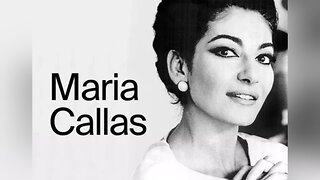 51:13
51:13
Adaneth - Arts & Literature
4 days agoLa Storia siamo Noi: Maria Callas (ENG SUB)
64 -
 10:27
10:27
Adam Does Movies
21 hours ago $0.43 earnedShelby Oaks - Movie Review
9.42K7 -
 6:08
6:08
Blackstone Griddles
14 hours agoAlmost Famous French Toast on the Blackstone Camping Griddle
11.9K -

BEK TV
1 day agoTrent Loos in the Morning - 10/23/2025
9.76K1 -
 LIVE
LIVE
The Bubba Army
22 hours agoImmigrant Trucker KILLS Again! - Bubba the Love Sponge® Show | 10/23/25
1,395 watching -
 LIVE
LIVE
Side Scrollers Podcast
3 days ago🔴FIRST EVER RUMBLE SUB-A-THON🔴DAY 3🔴WAKE YOUR ASS UP!
1,100 watching -
 19:16
19:16
Jasmin Laine
17 hours agoCBC Gets FACT-CHECKED By Guest—Carney BEGS Poilievre For Help
24.1K11 -
 8:50
8:50
The Shannon Joy Show
15 hours agoBREAKTHROUGH Cancer Treatments With Dr. Makis
11.5K3 -
 9:10
9:10
Faith Frontline
14 hours agoMatthew McConaughey Just Said What No Celebrity Dares to About Jesus
14K2 -
 27:03
27:03
Take FiVe - His Glory
1 day agoEp 2112: Sam Anthony: How Citizen Journalism is Replacing Legacy Media | Take Five
16.4K2

